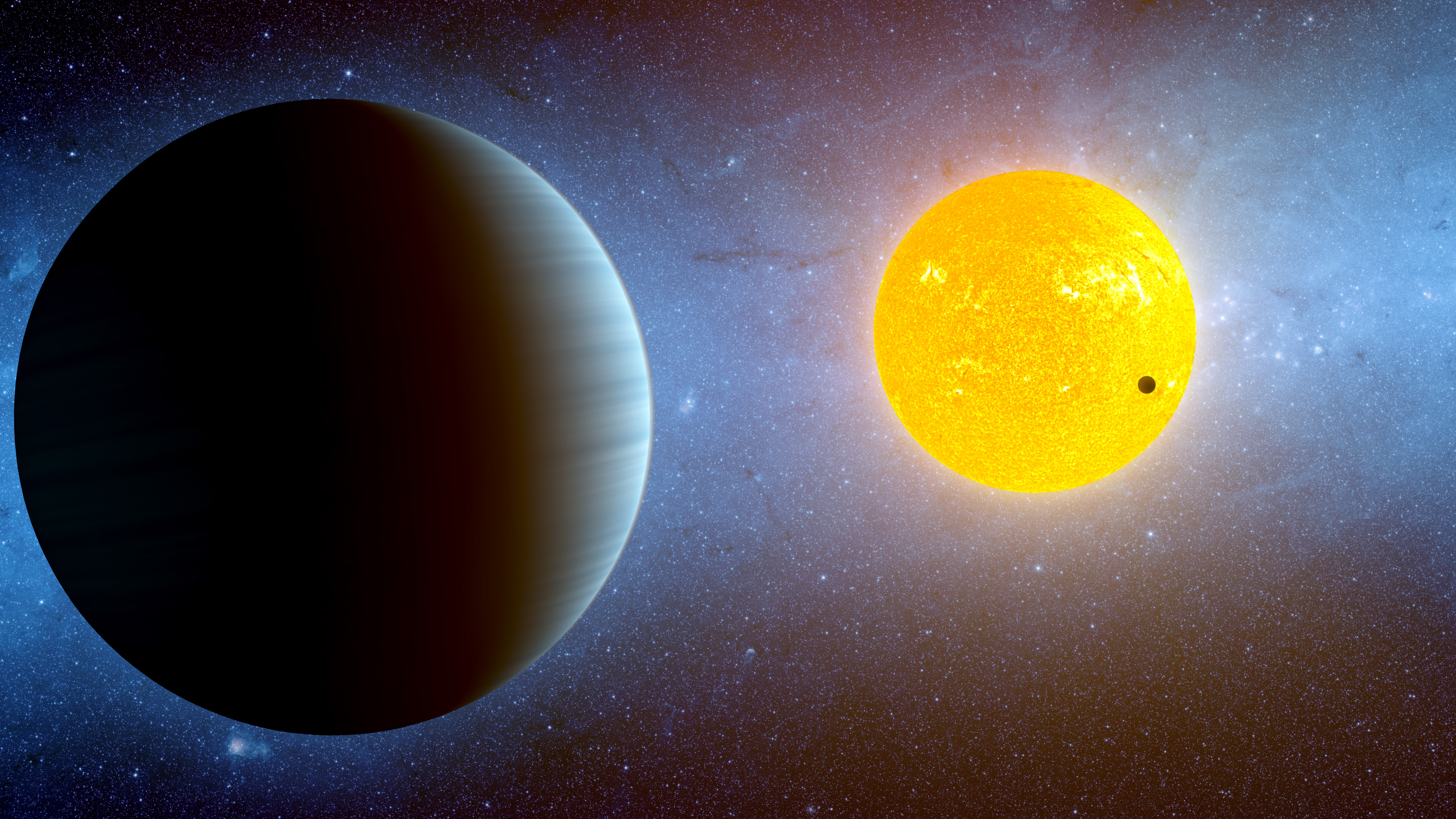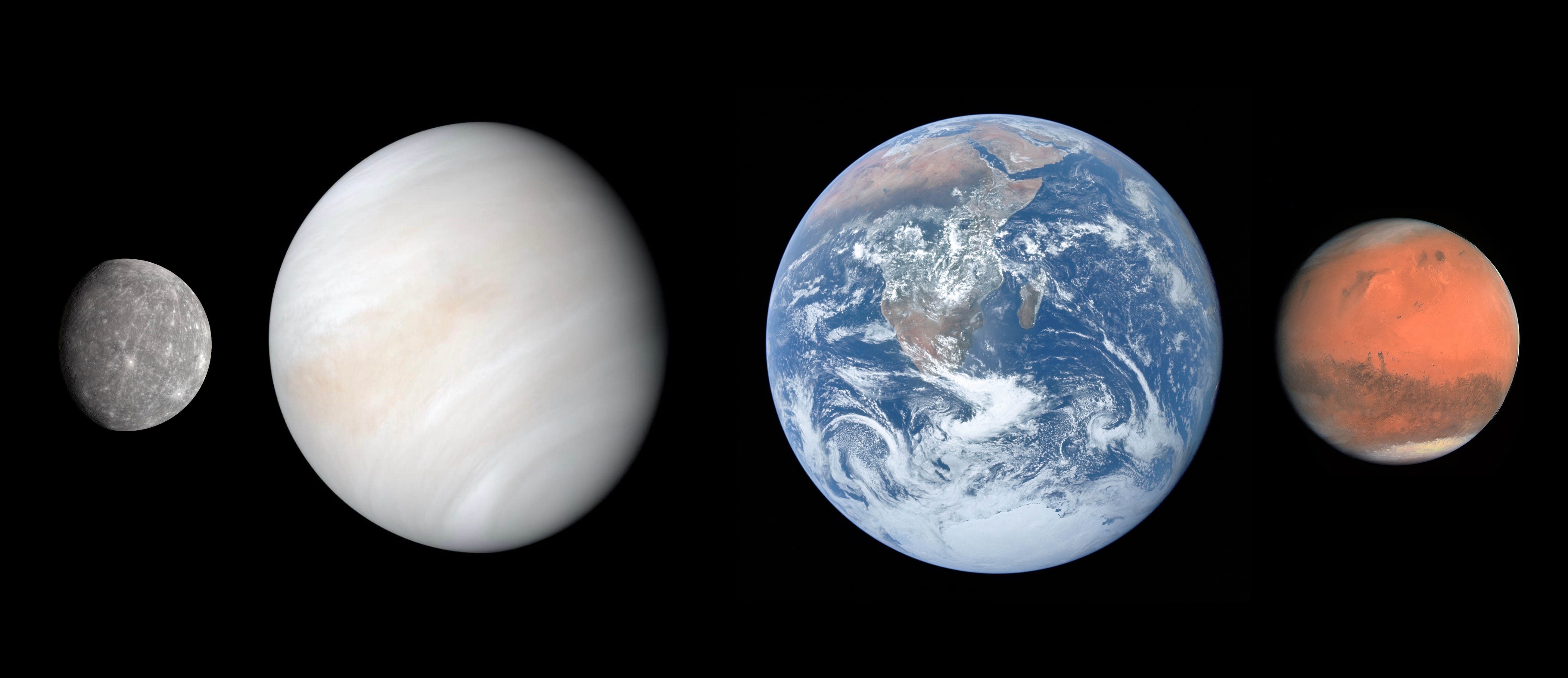|
Kepler-10
Kepler-10, formerly known as KOI-72, is a Sun-like star in the constellation of Draco (constellation), Draco that lies 187 parsecs (608 light years) from Earth. Kepler-10 was targeted by NASA's Kepler (spacecraft), Kepler spacecraft, as it was seen as the first star identified by the Kepler mission that could be a possible host to a small, transiting exoplanet. The star is slightly less massive, slightly larger, and slightly cooler than the Sun; at an estimated 10.4 billion years in age, Kepler-10 is almost 2.6 times the age of the Sun. Kepler-10 is host to a planetary system made up of at least two planets. Kepler-10b, the first undeniably rocky planet, was discovered in its orbit after eight months of observation and announced on January 10, 2011. The planet orbits its star closely, completing an orbit every 0.8 days, and has a density similar to that of iron. The second planet, Kepler-10c, was confirmed on May 23, 2011, based on follow-up observations by the Spitzer S ... [...More Info...] [...Related Items...] OR: [Wikipedia] [Google] [Baidu] |
Kepler-10c
Kepler-10c is an exoplanet orbiting the G-type star Kepler-10, located around 608 light-years away in Draco. Its discovery was announced by Kepler in May 2011, although it had been seen as a planetary candidate since January 2011, when Kepler-10b was discovered. The team confirmed the observation using data from NASA's Spitzer Space Telescope and a technique called BLENDER that ruled out most false positives. Kepler-10c was the third transiting planet to be confirmed statistically (based on probability rather than actual observation), after Kepler-9d and Kepler-11g. The Kepler team considers the statistical method that led to the discovery of Kepler-10c as what will be necessary to confirm many planets in Kepler's field of view. Kepler-10c orbits its host star every forty-five days at a quarter of the average distance between the Sun and Earth. Initial observations showed that it has a radius more than double that of Earth, and suggested a higher density, suggesting a mainly r ... [...More Info...] [...Related Items...] OR: [Wikipedia] [Google] [Baidu] |
Kepler-10b
Kepler-10b is the first confirmed terrestrial planet to have been discovered outside the Solar System by the Kepler Space Telescope. Discovered after several months of data collection during the course of the NASA-directed Kepler Mission, which aims to discover Earth-like planets crossing in front of their host stars, the planet's discovery was announced on January 10, 2011. Kepler-10b has a mass of 3.72±0.42 Earth masses and a radius of 1.47 Earth radii. However, it lies extremely close to its star, Kepler-10, and as a result is too hot to support life as we know it. Its existence was confirmed using measurements from the W.M. Keck Observatory in Hawaii. Nomenclature and history Kepler-10, the star that hosts Kepler-10b, is located 560 light-years from the Solar System in the Draco constellation. It is approximately the same size as the Sun, with an estimated age of 12 billion years. Planet Kepler-10b was the first planet to be discovered in the orbit of its star. For ... [...More Info...] [...Related Items...] OR: [Wikipedia] [Google] [Baidu] |
Rocky Planet
A terrestrial planet, telluric planet, or rocky planet, is a planet that is composed primarily of silicate Rock (geology), rocks or metals. Within the Solar System, the terrestrial planets accepted by the IAU are the inner planets closest to the Sun: Mercury (planet), Mercury, Venus, Earth and Mars. Among astronomers who use the geophysical definition of a planet, two or three planetary-mass moon, planetary-mass satellites – Earth's Moon, Io (moon), Io, and sometimes Europa (moon), Europa – may also be considered terrestrial planets; and so may be the rocky protoplanet-asteroids 2 Pallas, Pallas and 4 Vesta, Vesta.Emily Lakdawalla et al.What Is A Planet?The Planetary Society, 21 April 2020 The terms "terrestrial planet" and "telluric planet" are derived from Latin words for Earth (''Terra'' and ''Tellus''), as these planets are, in terms of structure, ''Earth-like''. Terrestrial planets are generally studied by geologists, astronomers, and geophysicists. Terrestrial planets ha ... [...More Info...] [...Related Items...] OR: [Wikipedia] [Google] [Baidu] |
Terrestrial Planet
A terrestrial planet, telluric planet, or rocky planet, is a planet that is composed primarily of silicate rocks or metals. Within the Solar System, the terrestrial planets accepted by the IAU are the inner planets closest to the Sun: Mercury, Venus, Earth and Mars. Among astronomers who use the geophysical definition of a planet, two or three planetary-mass satellites – Earth's Moon, Io, and sometimes Europa – may also be considered terrestrial planets; and so may be the rocky protoplanet-asteroids Pallas and Vesta.Emily Lakdawalla et al.What Is A Planet?The Planetary Society, 21 April 2020 The terms "terrestrial planet" and "telluric planet" are derived from Latin words for Earth (''Terra'' and ''Tellus''), as these planets are, in terms of structure, ''Earth-like''. Terrestrial planets are generally studied by geologists, astronomers, and geophysicists. Terrestrial planets have a solid planetary surface, making them substantially different from the larger gaseous plane ... [...More Info...] [...Related Items...] OR: [Wikipedia] [Google] [Baidu] |
Draco (constellation)
Draco is a constellation in the far northern sky. Its name is Latin for dragon. It was one of the 48 Lists of constellations, constellations listed by the 2nd century astronomer Ptolemy, and remains one of the 88 modern constellations today. The north pole of the ecliptic is in Draco. Draco is circumpolar star, circumpolar from northern latitudes. There it is never setting and therefore can be seen all year. Features Stars Thuban (α Draconis) was the northern pole star from 3942 BC, when it moved farther north than Theta Boötis, until 1793 BC. The Egyptian Pyramids were designed to have one side facing north, with an entrance passage geometrically aligned so that Thuban would be visible at night. Due to the effects of Axial precession (astronomy), precession, it would again be the pole star around the year AD 21000. It is a blue-white giant star of magnitude 3.7, 309 light-years from Earth. The traditional name of Alpha Draconis, Thuban, means "head of the serpent". T ... [...More Info...] [...Related Items...] OR: [Wikipedia] [Google] [Baidu] |
Planetary System
A planetary system is a set of gravitationally In physics, gravity () is a fundamental interaction which causes mutual attraction between all things with mass or energy. Gravity is, by far, the weakest of the four fundamental interactions, approximately 1038 times weaker than the stron ... bound non-Star, stellar objects in or out of orbit around a star or star system. Generally speaking, systems with one or more planets constitute a planetary system, although such systems may also consist of bodies such as dwarf planets, asteroids, natural satellites, meteoroids, comets, planetesimals and circumstellar disks. The Sun together with the planetary system revolving around it, including Earth, forms the Solar System. The term exoplanetary system is sometimes used in reference to other planetary systems. Debris disks are also known to be common, though other objects are more difficult to observe. Of particular interest to astrobiology is the habitable zone of planetary sy ... [...More Info...] [...Related Items...] OR: [Wikipedia] [Google] [Baidu] |
Kepler-10 Star System
GSC 03549-02811 (sometimes referred to as TrES-2 A or TrES-2 parent star in reference to its exoplanet TrES-2b), also known as Kepler-1) is a yellow main-sequence star similar to the Sun. This star is located approximately 704 light-years away in the constellation of Draco. The apparent magnitude of this star is 11.41, which means it is not visible to the naked eye but can be seen with a medium-sized amateur telescope on a clear dark night. The age of this star is about 5 billion years. Planetary system In 2006 the exoplanet TrES-2b was discovered by the TrES program using the transit method. It is also within the field of view of the previously operational Kepler Mission planet-hunter spacecraft. This system continues to be studied by other projects and the parameters are continuously improved. The planet orbits the primary star. Though TrES-2b is currently the darkest known exoplanet, reflecting less than 1 percent of local sunlight, it shows a faint red glow. ... [...More Info...] [...Related Items...] OR: [Wikipedia] [Google] [Baidu] |
Goddard Space Flight Center
The Goddard Space Flight Center (GSFC) is a major NASA space research laboratory located approximately northeast of Washington, D.C. in Greenbelt, Maryland, United States. Established on May 1, 1959 as NASA's first space flight center, GSFC employs approximately 10,000 civil servants and contractors. It is one of ten major NASA field centers, named in recognition of American rocket propulsion pioneer Robert H. Goddard. GSFC is partially within the former Goddard census-designated place; it has a Greenbelt mailing address.CENSUS 2000 BLOCK MAP: GODDARD CDP " . Retrieved on September 1, 2018. 1990 Census map of Prince ... [...More Info...] [...Related Items...] OR: [Wikipedia] [Google] [Baidu] |
Effective Temperature
The effective temperature of a body such as a star or planet is the temperature of a black body that would emit the same total amount of electromagnetic radiation. Effective temperature is often used as an estimate of a body's surface temperature when the body's emissivity curve (as a function of wavelength) is not known. When the star's or planet's net emissivity in the relevant wavelength band is less than unity (less than that of a black body), the actual temperature of the body will be higher than the effective temperature. The net emissivity may be low due to surface or atmospheric properties, including greenhouse effect. Star The effective temperature of a star is the temperature of a black body with the same luminosity per ''surface area'' () as the star and is defined according to the Stefan–Boltzmann law . Notice that the total (bolometric) luminosity of a star is then , where is the stellar radius. The definition of the stellar radius is obviously not straightf ... [...More Info...] [...Related Items...] OR: [Wikipedia] [Google] [Baidu] |
Kelvin Scale
The kelvin, symbol K, is the primary unit of temperature in the International System of Units (SI), used alongside its prefixed forms and the degree Celsius. It is named after the Belfast-born and University of Glasgow-based engineer and physicist William Thomson, 1st Baron Kelvin (1824–1907). The Kelvin scale is an absolute thermodynamic temperature scale, meaning it uses absolute zero as its null (zero) point. Historically, the Kelvin scale was developed by shifting the starting point of the much-older Celsius scale down from the melting point of water to absolute zero, and its increments still closely approximate the historic definition of a degree Celsius, but since 2019 the scale has been defined by fixing the Boltzmann constant to be exactly . Hence, one kelvin is equal to a change in the thermodynamic temperature that results in a change of thermal energy by . The temperature in degree Celsius is now defined as the temperature in kelvins minus 273.15, meaning tha ... [...More Info...] [...Related Items...] OR: [Wikipedia] [Google] [Baidu] |
Extrasolar Planets Encyclopaedia
The Extrasolar Planets Encyclopaedia is an astronomy website, founded in Paris, France at the Meudon Observatory by Jean Schneider in February 1995, which maintains a database of all the currently known and candidate extrasolar planets, with individual pages for each planet and a full list interactive catalog spreadsheet. The main catalogue comprises databases of all of the currently confirmed extrasolar planets as well as a database of unconfirmed planet detections. The databases are frequently updated with new data from peer-reviewed publications and conferences. In their respective pages, the planets are listed along with their basic properties, including the year of planet's discovery, mass, radius, orbital period, semi-major axis, eccentricity, inclination, longitude of periastron, time of periastron, maximum time variation, and time of transit, including all error range values. The individual planet data pages also contain the data on the parent star, including name, di ... [...More Info...] [...Related Items...] OR: [Wikipedia] [Google] [Baidu] |
Naked Eye
Naked eye, also called bare eye or unaided eye, is the practice of engaging in visual perception unaided by a magnifying, light-collecting optical instrument, such as a telescope or microscope, or eye protection. Vision corrected to normal acuity using corrective lenses is still considered "naked". In astronomy, the naked eye may be used to observe celestial events and objects visible without equipment, such as conjunctions, passing comets, meteor showers, and the brightest asteroids, including 4 Vesta. Sky lore and various tests demonstrate an impressive variety of phenomena visible to the unaided eye. Basic properties Some basic properties of the human eye are: *Quick autofocus from distances of 25 cm (young people) to 50 cm (most people 50 years and older) to infinity. * Angular resolution: about 1 arcminute, approximately 0.017° or 0.0003 radians, which corresponds to 0.3 m at a 1 km distance. *Field of view (FOV): simultaneous visual percepti ... [...More Info...] [...Related Items...] OR: [Wikipedia] [Google] [Baidu] |









